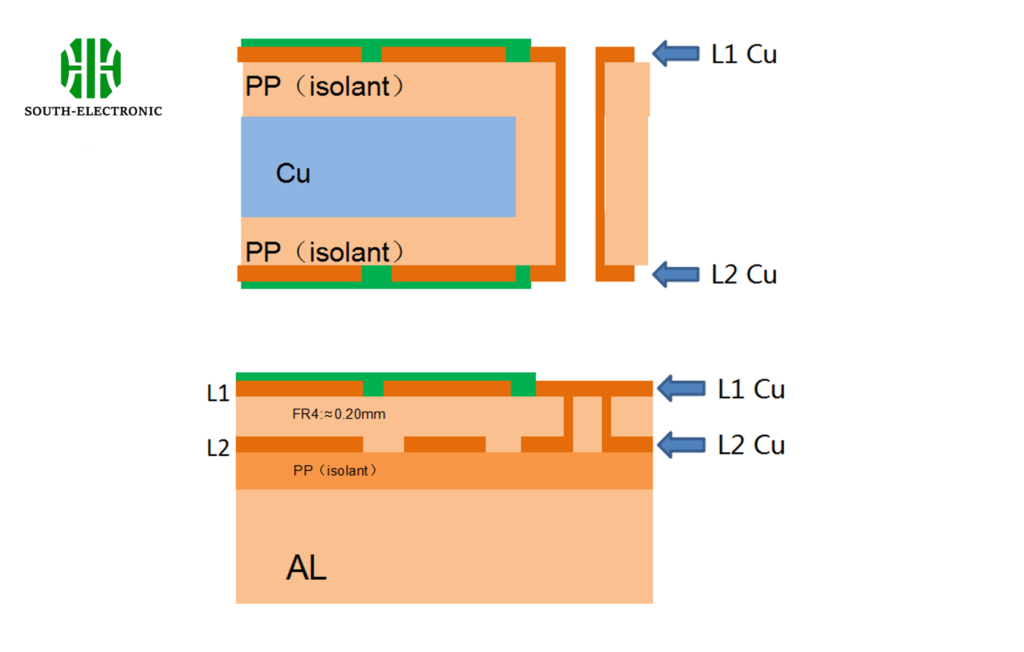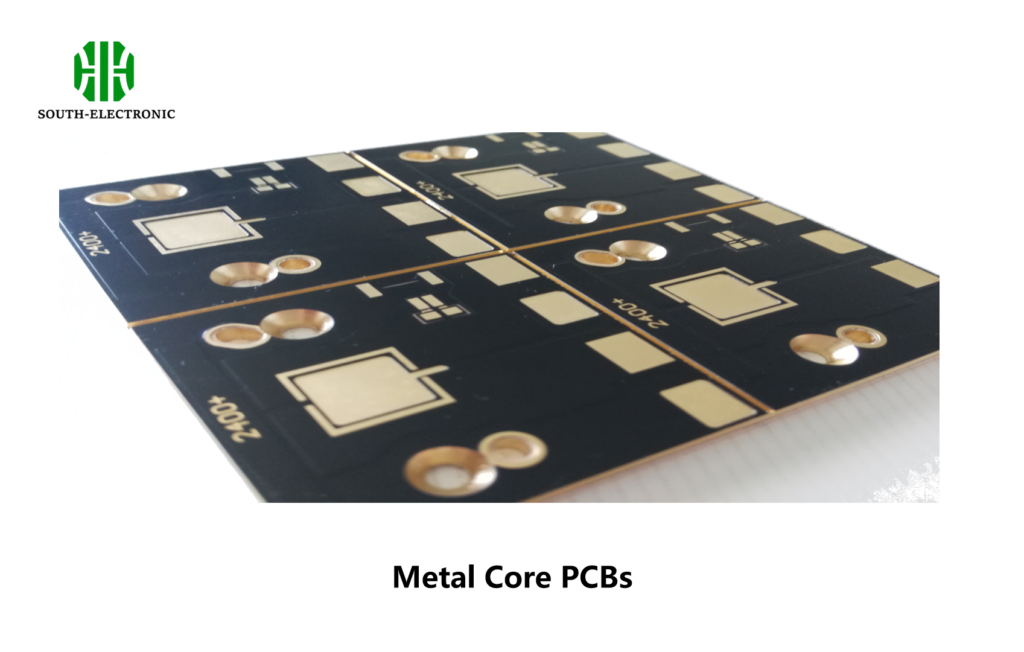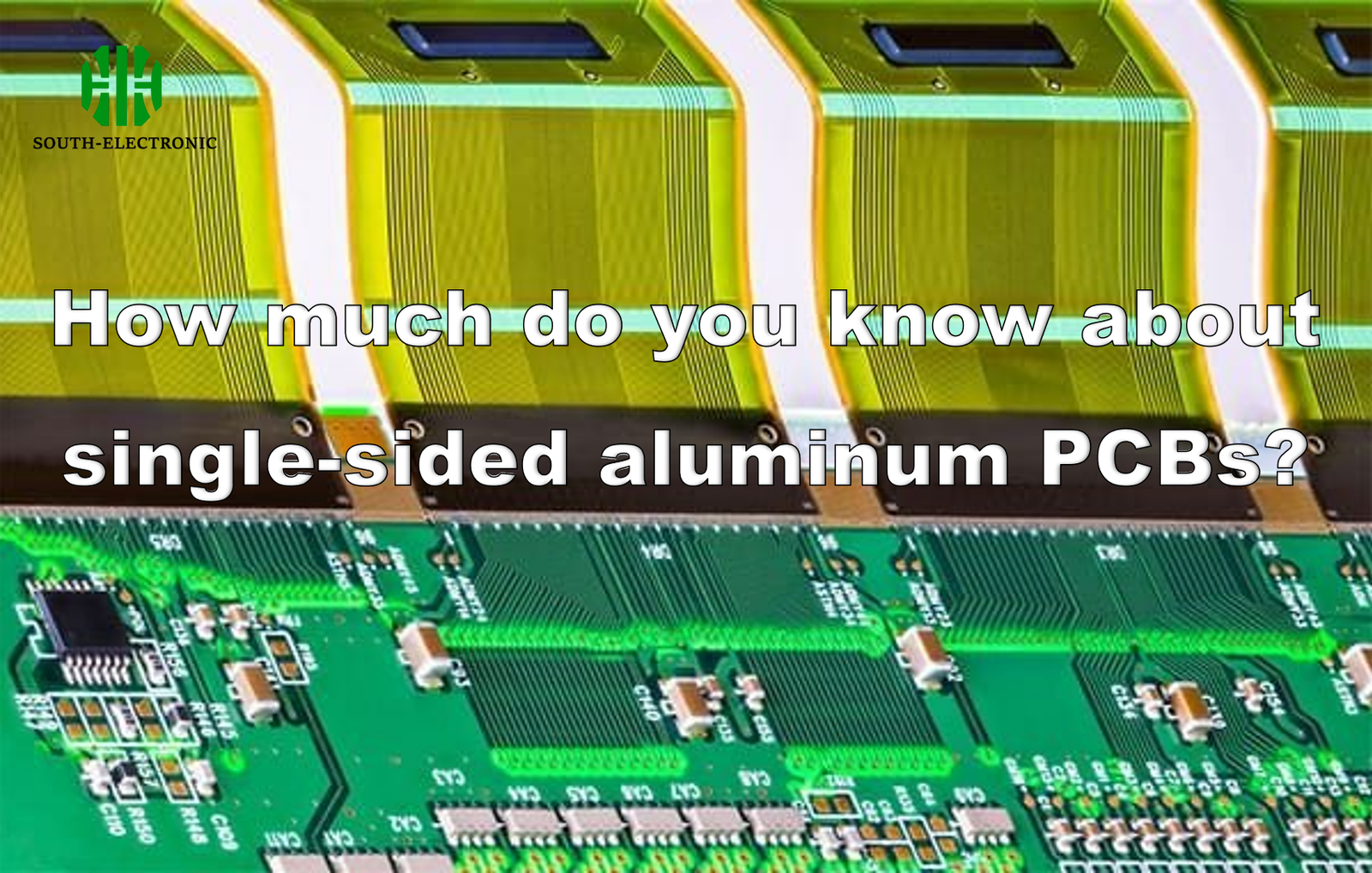Among electronic PCB materials, aluminum PCBs stand out for their excellent overall heat dissipation performance.
Although aluminum’s pure metal thermal conductivity (approximately 237 W/(m·K)) is lower than copper’s (approximately 400 W/(m·K)), its unique metal-based composite structure (aluminum base + insulation layer + circuit layer) combined with aluminum’s lightweight, low-cost, and high-machinability allows for more efficient heat dissipation. Furthermore, aluminum PCBs offer reliable electrical insulation and excellent machinability.
This combination of efficient heat dissipation, electrical safety, and easy machinability makes them an ideal choice for solving the heat dissipation challenges of high-power, high-density electronic devices, making them a popular choice in the market.
Aluminum PCB Structure
Let’s take a look at two aluminum PCB structures: Double-sided sandwich aluminum substrate and double-sided mixed pressure aluminum substrate

Aluminum PCBs (Aluminum Base PCBs), as a high-performance metal-based copper-clad laminate (MCPCB), have a core advantage in their excellent heat dissipation performance.
Based on the distribution of the conductive circuit layers, PCBs are primarily categorized into single-sided and double-sided boards.
Single-sided boards: They employ a basic three-layer structure, consisting of a circuit layer (copper foil), an insulating layer, and a metal base layer (aluminum plate).
Double-sided boards: They have a more complex structure, consisting of a symmetrical five-layer stack: circuit layer – insulating layer – metal base layer (aluminum plate) – insulating layer – circuit layer. This design enables double-sided wiring, making it suitable for higher-density and more complex circuit designs and is commonly found in high-end applications.
Configuration and Characteristics of Each Functional Layer in a Single-Sided Aluminum PCB
- Circuit Layer

Function and Positioning: As the conductive layer of the aluminum substrate, it functions similarly to the copper cladding layer on a standard FR-4 PCB, supporting electronic components and enabling electrical interconnections.
Construction and Processing: Electrolytic copper foil (ED copper foil) is typically used, with the desired circuit pattern formed through an etching process.
Common thickness range: 1 oz (approximately 35 μm) to 10 oz (approximately 280 μm).
Core Relationship: Copper foil thickness directly determines current carrying capacity. The thicker the foil, the higher the current it can carry.
Thickness Selection Considerations: This range (1oz – 10oz) generally offers an optimal balance between current carrying requirements, heat dissipation performance, processability (such as etching accuracy), and cost.
- Dielectric Layer – Core Technical Layer

Core Status and Function: The dielectric layer is a decisive factor in the performance of aluminum substrates, fulfilling three key functions:
Electrical Insulation: Provides high-strength, reliable isolation between the circuit layer and the metal substrate, preventing short circuits.
Efficient Thermal Conductivity: Serves as the primary heat conduction path, efficiently transferring heat generated by the circuit layer to the metal substrate.
Mechanical Bonding: Securely bonds the circuit layer to the metal substrate, ensuring structural integrity.
Material Composition: Typically made of a high-performance polymer matrix (such as modified epoxy resin or polyimide) filled with highly thermally conductive specialty ceramic powders (such as alumina, boron nitride, or aluminum nitride). This composite material design is the foundation for its unique properties.
Key Performance Requirements:
Low Thermal Resistance: This is a direct measure of how easily heat can pass through a layer and should be kept as low as possible.
High Thermal Conductivity: The thermal conductivity of the material itself (unit: W/(m·K)) directly determines the overall heat dissipation efficiency of the aluminum substrate. The higher the thermal conductivity, the faster and more efficient the heat transfer from the device to the heat dissipation substrate.
High Dielectric Strength: It must withstand high electric fields without breakdown to ensure electrical safety.
Excellent Viscoelastic Properties: It effectively buffers the thermomechanical stress caused by the difference in the coefficient of thermal expansion (CTE) between the circuit layer and the metal base layer, preventing delamination and cracking.
Long-Term Thermal Stability/Aging Resistance: Maintains stable performance and resistance to degradation in the high-temperature environments of long-term device operation.
Performance Impact: The thermal conductivity of the insulation layer is crucial.
The more significantly the device operating temperature is reduced, the higher the power density and reliability of the device/module.
This contributes to a more compact design (reduced size) and a longer service life.
- Metal Substrate

Function and Core Requirements: The metal substrate serves as the mechanical support core and ultimate heat dissipation channel for the aluminum substrate. Its most critical requirement is excellent thermal conductivity to efficiently diffuse and dissipate heat conducted from the insulation layer.
Common Materials: Aluminum or copper are primarily used.
Key Considerations for Material Selection:
Thermal Conductivity: This is the key parameter that determines heat dissipation efficiency (aluminum ≈ 237 W/(m·K), copper ≈ 400 W/(m·K)).
Coefficient of Thermal Expansion (CTE): The CTE must match the circuit layer (usually copper) and the components mounted on it (such as chips) as closely as possible to minimize thermal stress and prevent solder joint failure or delamination.
Mechanical Properties: These include strength (bending and deformation resistance) and hardness (affecting processability and wear resistance).
Density/Weight: Directly impacts the weight of the final product (aluminum ≈ 2.7 g/cm³, copper ≈ 8.9 g/cm³).
Surface Condition: Flatness and surface treatments (such as anodized aluminum for improved corrosion resistance, insulation, or adhesion) are crucial.
Cost: Material and processing costs are key commercial considerations.
Mainstream Choice – Aluminum Alloy Sheet:
Reasons of Preference: Offers the best balance between overall performance (thermal conductivity, mechanical strength, and processability) and cost.
Common Alloy Grades: Examples include 1060 (high-purity aluminum, excellent thermal conductivity), 5052 (excellent strength/corrosion resistance), and 6061 (excellent overall performance and high strength).
High-Performance Choice – Copper Sheet:
Core Advantage: Significantly better thermal conductivity than aluminum (approximately 70% higher), providing exceptional heat dissipation capabilities.
Major Disadvantages: Significantly higher cost and higher density (heavy weight).
Applicable Applications: Applications with extremely stringent heat dissipation requirements and where cost/weight are not primary constraints.
Processability: Both aluminum alloy and copper plates exhibit excellent machinability, making them easily accessible for standard PCB post-processing steps such as drilling, stamping, cutting (V-cuts), and milling.



